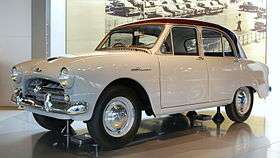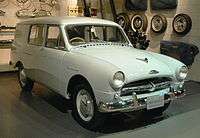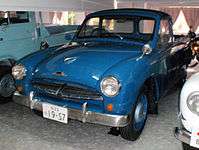Toyopet Master
| Toyopet Master series RR | |
|---|---|
 | |
| Overview | |
| Manufacturer | Toyota (Kanto Auto Works) |
| Production | Jan 1955–Nov 1956 |
| Assembly | Japan |
| Body and chassis | |
| Class | Compact |
| Body style | sedan |
| Layout | front-engine, rear-wheel drive |
| Platform | ladder frame |
| Related |
Toyopet Crown RS Toyopet Toyoace SKB |
| Powertrain | |
| Engine | 1,453 cc type R OHV I4 |
| Chronology | |
| Predecessor | Toyota RH |
| Successor | Toyota Corona |
The Toyopet Master, introduced in January 1955,[1] is a passenger car that was an update to the SF/RH model with a modernized body. As for its predecessor, it has a ladder frame with leaf sprung front and rear axles. The Toyopet Master was an evolution of an earlier Toyota sedan called the Toyota SF/RH model (also known as the Super), and was sold in parallel with the first Toyota Crown. The more conservative Master was introduced as a frugally equipped version meant for taxi usage.[2] The Master and Crown shared the same R-series engine, which produces 48 PS (35 kW) in the Master.[3] It was sold at a chain of Toyota Japan dealerships called Toyota Store, next to the more upscale Crown, which was intended as a private purchase alternative to the Master.
In 1955 Toyota wasn't sure if its independent front coil suspension and its rear-hinged back doors installed on the Crown wouldn't be too radical for the taxi market to accept. When sales of the Crown proved satisfying, the Master was discontinued in November 1956, and replaced with the smaller Toyota Corona in 1957, at a new Toyota Japanese dealership called Toyopet Store. The RR Master's body panels were used in cut-down form as an economical and fast way to design this new ST10 Corona. Production facilities for the Master were transferred to the Crown.[4]
The Toyopet Master range also included the Masterline RR16 pickup, the Masterline RR17 van and the Masterline RR19 double pickup (with two rows of seats).[5] They were introduced in November 1955, originally only as a single-cab pickup and a van.[1] The double pickup was added in August 1956, around which time the engine was upgraded to provide 55 PS (40 kW).[3] These replaced the SG commercial models and were the first car-based trucks to enter production in Japan.[2] The Masterline commercial models were carried over after the discontinuation of the Master. They were built until replaced by a new Crown-based Masterline in March 1959,[6] for the Toyota Store sales channel. A smaller Coronaline version was also developed to be sold through Toyopet dealers.
In 1995, Toyota revisited the approach of a commercial grade Crown sedan, designed primarily for taxi usage, and introduced the Toyota Comfort which is still in production, with prolific usage across Asia.
Dates and production figures
Produced from January 1955 to November 1956.
|
References
- 1 2 Ozeki, Kazuo (2007).
日本のトラック・バス 1917~1975 [Japanese Trucks and Buses 1917-1975:] (in Japanese). Tokyo: Miki Press. p. 56. ISBN 978-4-89522-487-1. - 1 2 昭和自動車史 [Showa automobile history]. 別冊1億人の昭和史 [Supplement: History of 100 million people during Showa] (in Japanese). Mainichi Shimbun. 1979. p. 259.
- 1 2 Ozeki, p. 57
- ↑ "Toyota: A history of the First 50 Years", Toyota Motor Corporation, 1988, ISBN 0-517-61777-3, pp. 133, 135, 137
- ↑ Toyota Automobile Museum (Japanese)
- ↑ Ozeki, p. 58

